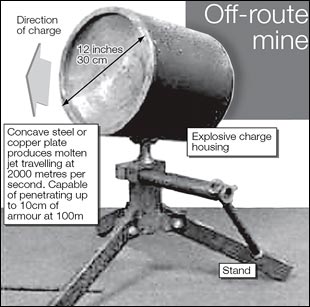The first picture of an Iraqi insurgent mine, believed to have been responsible for the deaths of 17 British soldiers, has been obtained by The Sunday Telegraph.
The device, which has been used by insurgents throughout Iraq since May last year, fires an armour-piercing "explosively formed projectile" or EFP, also known as a shaped charge, directly into an armoured vehicle, inflicting death or terrible injuries on troops inside.
The weapon can penetrate the armour of British and American tanks and armoured personnel carriers and completely destroy armoured Land Rovers, which are used by the majority of British troops on operations in Iraq.
The device, described as an "off-route mine", was seized by British troops in Iraq earlier this year and brought back to Britain where it underwent detailed examination by scientists at Fort Halstead, the Government's forensic explosive laboratory in Kent.
The Ministry of Defence has attempted to play down the effectiveness of the weapons, suggesting that they are "crude" or "improvised" explosive devices which have killed British troops more out of luck than judgement.
However, this newspaper understands that Government scientists have established that the mines are precision-made weapons which have been turned on a lathe by craftsmen trained in the manufacture of munitions.
A source from the American military, who has been working closely with British scientists, said that the insurgents have perfected the design of the weapon and know exactly where to place it to ensure maximum damage to coalition vehicles...




 Reply With Quote
Reply With Quote





 ) wasn't RMA but simply next step in evolution of a bow.
) wasn't RMA but simply next step in evolution of a bow.



Bookmarks